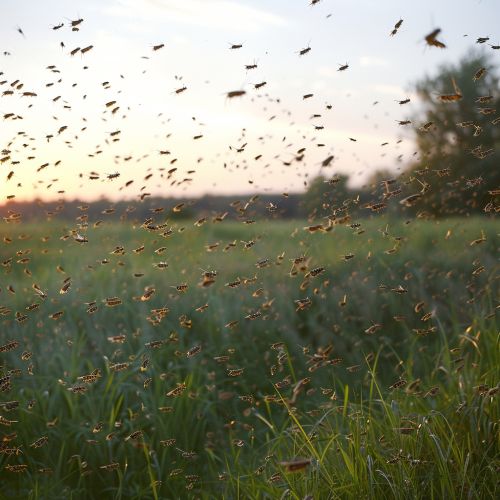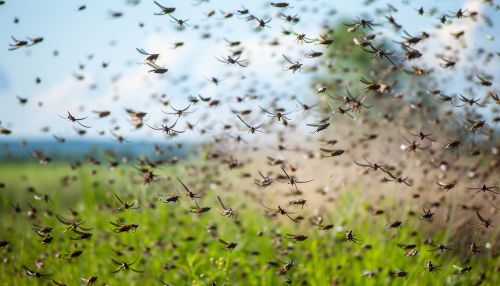Locust Plague
Introduction
A locust plague is a phenomenon where large swarms of locusts infest and devastate agricultural regions, leading to significant economic and social impacts. These plagues have been recorded throughout history and continue to pose a threat to food security in various parts of the world. Locusts are a type of grasshopper that can undergo a phase transformation from solitary to gregarious behavior, leading to the formation of massive swarms capable of traveling long distances and consuming vast amounts of vegetation.
Biology of Locusts
Locusts belong to the family Acrididae within the order Orthoptera. They exhibit a unique form of phenotypic plasticity, which allows them to switch between solitary and gregarious phases. This transformation is triggered by environmental factors such as population density and availability of food resources. The gregarious phase is characterized by increased mobility, changes in coloration, and heightened reproductive rates.
Life Cycle
The life cycle of locusts includes several stages: egg, nymph (hopper), and adult. The duration of each stage can vary depending on environmental conditions. Eggs are typically laid in the soil, where they remain dormant until favorable conditions trigger hatching. Nymphs undergo multiple molts before reaching adulthood. During the gregarious phase, locusts exhibit synchronized development, leading to the formation of swarms.
Causes of Locust Plagues
Locust plagues are primarily driven by climatic and environmental factors. Favorable weather conditions, such as prolonged periods of rainfall, can lead to an increase in vegetation, providing ample food resources for locusts. This abundance of food can trigger rapid population growth and the transition to the gregarious phase. Additionally, changes in land use and agricultural practices can create environments conducive to locust breeding and swarming.


Historical Plagues
Locust plagues have been documented throughout history, with some of the earliest records dating back to ancient civilizations. These events have often been associated with significant social and economic upheaval. For example, the Plagues of Egypt described in the Bible include a devastating locust plague. More recent historical plagues include the 1926-1934 locust plague in Africa, which affected millions of hectares of farmland and caused widespread famine.
Impact on Agriculture
The impact of locust plagues on agriculture can be catastrophic. Swarms can consume vast amounts of crops and pasture, leading to significant losses in food production. This can result in food shortages, increased prices, and economic instability. The damage caused by locusts is not limited to crops; they can also destroy trees and other vegetation, leading to long-term ecological consequences.
Economic Consequences
The economic consequences of locust plagues are profound. Farmers can suffer substantial financial losses due to crop destruction, and the cost of control measures can be significant. Governments and international organizations often invest heavily in locust control programs to mitigate the impact of plagues. The indirect costs, such as loss of income and increased food prices, can also have far-reaching effects on communities and economies.
Control and Management
Effective control and management of locust plagues require a combination of strategies, including monitoring, early warning systems, and direct intervention. Monitoring involves tracking locust populations and environmental conditions to predict potential outbreaks. Early warning systems use data from monitoring efforts to alert authorities and communities about impending plagues.
Chemical Control
Chemical control is one of the most common methods used to manage locust plagues. Insecticides are applied to infested areas to kill locusts and prevent the formation of swarms. However, the use of chemicals can have negative environmental and health impacts, and there is a risk of locusts developing resistance to insecticides.
Biological Control
Biological control involves the use of natural enemies and pathogens to manage locust populations. For example, the fungus Metarhizium anisopliae has been used to infect and kill locusts. Biological control methods are generally considered more environmentally friendly than chemical control, but they can be less effective and slower to act.
Integrated Pest Management (IPM)
Integrated Pest Management (IPM) combines multiple control strategies to manage locust plagues in a sustainable and effective manner. IPM approaches may include the use of chemical and biological control methods, habitat management, and the promotion of natural predators. The goal of IPM is to reduce locust populations to manageable levels while minimizing environmental and economic impacts.
Climate Change and Locust Plagues
Climate change is expected to influence the frequency and intensity of locust plagues. Changes in temperature and precipitation patterns can alter the habitats and breeding conditions for locusts, potentially leading to more frequent and severe outbreaks. Understanding the relationship between climate change and locust behavior is crucial for developing effective long-term management strategies.
Research and Innovations
Ongoing research and innovations are critical for improving the management of locust plagues. Advances in remote sensing and geographic information systems (GIS) have enhanced the ability to monitor and predict locust movements. Additionally, research into the genetic and physiological mechanisms underlying locust phase transformation may lead to new control methods. Collaborative efforts between scientists, governments, and international organizations are essential for addressing the global challenge of locust plagues.
